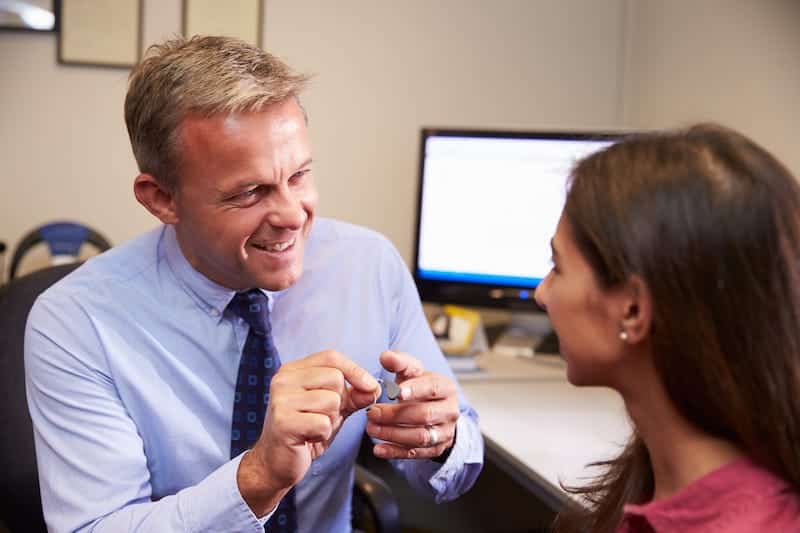By Shari Eberts
Paula knows that she sounds like a broken record to her family and friends. “Please face me when you talk to me. Let me sit in the corner so I can avoid the background noise.” The list goes on and on.
For years she was unaware of many of these tactics. Her conversations with family, friends, and co-workers were frustrating. She would try to bluff, or use context clues to keep the dialogue going, but it was exhausting and unsatisfying—for both sides. When she told her audiologist about it, he fiddled with the settings on her devices rather than providing other solutions.
Paula eventually learned communication best practices on her own, but she lost many years in the process. She wishes her audiologist had shared more of these critical communication skills with her at the very start of her journey and at each appointment thereafter.
What was missing? Thinking beyond the technology.
Why is Thinking Beyond the Technology Important?
Many people with hearing loss are starting from scratch. They may not know other people with hearing loss or have anyone they can talk to about what they are experiencing. Often, they try hearing aids, but quickly realize that devices can’t do it all. It is frustrating because they don’t know what else they can do to improve communication.
This is one of the reasons Gael Hannan and I wrote “Hear & Beyond: Live Skillfully with Hearing Loss.” We both struggled for years to put together the right toolkit to live well with hearing loss. In the book, we share the knowledge we gained over our decades of experience to help smooth the path for others.
Hearing care professionals are important for filling in these gaps, too. When you teach your clients the other communication skills that they need to unleash the power of their hearing aids, the devices are less likely to remain unused in a drawer or be returned to you at the end of the trial period.
Further reading: Emphasizing Patient Care in the OTC Era
Five Ways to Help Clients Get More from their Hearing Aids
Hearing aids work great for a one-on-one conversation in a quiet space, but in noisier settings, they aren’t always enough to create good communication. Help your clients prepare for more challenging listening situations with non-technical communication tools, too.
Share Best Practice Communication Tips
Getting the person’s attention before speaking or making sure to face the person and speak in a clear and steady manner may seem like obvious ways to improve communication, but they may not be to people with hearing loss (or their families!) at the start of the journey. Share a written cheat sheet of communication tips with your clients at every appointment to refresh their memory and so they can share it with their communication partners.
Teach Your Patients to Be Better Listeners
While many best practices rely on communication partners to make changes, there are also things people with hearing loss can
do to ease conversation. Examples include staying up to date on the news and other happenings so they can recognize new names more easily or to schedule important conversations for the morning when they are well rested.
Help them Manage Hearing Loss Exhaustion
A long day of communication can be exhausting for a person with hearing loss because listening takes work. Warn your clients about this so they know what to expect and how to pace themselves to maintain energy throughout the day.
Promote Self-Advocacy Skills
People with hearing loss must learn to ask for the assistance they need from their communication partners, but this can be tricky at first. Empower them by teaching them ways to ask for the help they need. Ideas include setting ground rules for conversations up front or using non-verbal cues like placing a hand behind the ear to let the speaker know to speak up without interrupting the flow of the conversation.
Recommend Hearing Loss Support Groups
Meeting other people with hearing loss helps clients build confidence and overcome feelings of stigma. These groups are also great sources of technical and non-technical communication workarounds. Connect your patients to a local chapter of Hearing Loss Association of America or a similar group to help them build their skills. Attend the meetings yourself for greater insight into the lived hearing loss experience.
Your expertise goes well beyond hearing aid technology. Sharing what else you know will improve hearing outcomes, boost customer satisfaction, and deepen your relationships with your clients—a win-win for both sides of the client chair.
About the author: Shari Eberts is a passionate hearing health advocate and internationally recognized author and speaker. She is the founder of Living with Hearing Loss, a popular blog for people with hearing loss. Eberts has an adult-onset genetic hearing loss and hopes that by sharing her story, she will help others to live more peacefully with their own hearing issues.
Photo: Dreamstime





